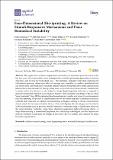| dc.contributor.author | Morouço, Pedro | |
| dc.contributor.author | Azimi, Bahareh | |
| dc.contributor.author | Milazzo, Mario | |
| dc.contributor.author | Mokhtari, Fatemeh | |
| dc.contributor.author | Fernandes, Cristiana | |
| dc.contributor.author | Reis, Diana | |
| dc.contributor.author | Danti, Serena | |
| dc.date.accessioned | 2021-02-17T16:48:28Z | |
| dc.date.available | 2021-02-17T16:48:28Z | |
| dc.date.issued | 2020-12 | |
| dc.date.submitted | 2020-12 | |
| dc.identifier.issn | 2076-3417 | |
| dc.identifier.uri | https://hdl.handle.net/1721.1/129787 | |
| dc.description.abstract | The applications of tissue engineered constructs have witnessed great advances in the last few years, as advanced fabrication techniques have enabled promising approaches to develop structures and devices for biomedical uses. (Bio-)printing, including both plain material and cell/material printing, offers remarkable advantages and versatility to produce multilateral and cell-laden tissue constructs; however, it has often revealed to be insufficient to fulfill clinical needs. Indeed, three-dimensional (3D) (bio-)printing does not provide one critical element, fundamental to mimic native live tissues, i.e., the ability to change shape/properties with time to respond to microenvironmental stimuli in a personalized manner. This capability is in charge of the so-called “smart materials”; thus, 3D (bio-)printing these biomaterials is a possible way to reach four-dimensional (4D) (bio-)printing. We present a comprehensive review on stimuli-responsive materials to produce scaffolds and constructs via additive manufacturing techniques, aiming to obtain constructs that closely mimic the dynamics of native tissues. Our work deploys the advantages and drawbacks of the mechanisms used to produce stimuli-responsive constructs, using a classification based on the target stimulus: humidity, temperature, electricity, magnetism, light, pH, among others. A deep understanding of biomaterial properties, the scaffolding technologies, and the implant site microenvironment would help the design of innovative devices suitable and valuable for many biomedical applications. | en_US |
| dc.publisher | MDPI AG | en_US |
| dc.relation.isversionof | http://dx.doi.org/10.3390/app10249143 | en_US |
| dc.rights | Creative Commons Attribution | en_US |
| dc.rights.uri | https://creativecommons.org/licenses/by/4.0/ | en_US |
| dc.source | Multidisciplinary Digital Publishing Institute | en_US |
| dc.title | Four-Dimensional (Bio-)printing: A Review on Stimuli-Responsive Mechanisms and Their Biomedical Suitability | en_US |
| dc.type | Article | en_US |
| dc.identifier.citation | Morouço, Pedro et al. "Four-Dimensional (Bio-)printing: A Review on Stimuli-Responsive Mechanisms and Their Biomedical Suitability." Applied Sciences 10, 24 (December 2020): 9143 © 2020 The Authors | en_US |
| dc.contributor.department | Massachusetts Institute of Technology. Department of Civil and Environmental Engineering | en_US |
| dc.relation.journal | Applied Sciences | en_US |
| dc.eprint.version | Final published version | en_US |
| dc.type.uri | http://purl.org/eprint/type/JournalArticle | en_US |
| eprint.status | http://purl.org/eprint/status/PeerReviewed | en_US |
| dc.date.updated | 2020-12-24T15:33:56Z | |
| dspace.date.submission | 2020-12-24T15:33:56Z | |
| mit.journal.volume | 10 | en_US |
| mit.journal.issue | 24 | en_US |
| mit.license | PUBLISHER_CC | |
| mit.metadata.status | Complete | |
